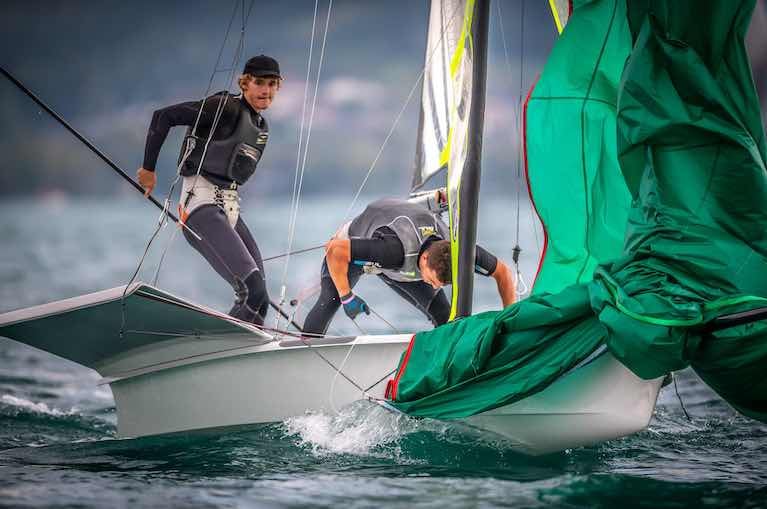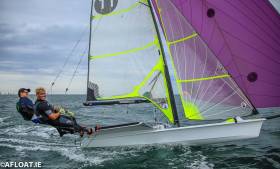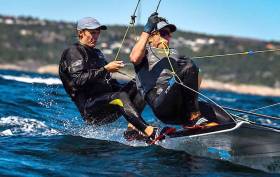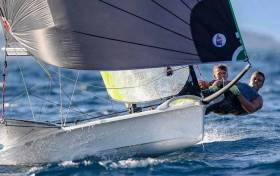Displaying items by tag: Robert Dickson & Sean Waddilove
Robert Dickson and Sean Waddilove have withdrawn their protest for a UFD penalty made against them in today's important Lanzarote International Regatta, the final Olympic Qualification event for the European 49er fleet.
As Afloat reported earlier, Dickson and Waddilove did file a protest seeking redress in the second race, claiming they were incorrectly identified as being over the line. However, when they appeared in front of the jury this afternoon it was to withdraw the protests, so the results stand.
Three of the seven countries seeking the one available Olympic slot have qualified for the gold fleet.
Belgium is in ninth place, while Italy has boats in 15th, 18th and 19th places. The top 25 boats from the qualifying series will compete in the gold fleet finals, carrying forward their scores from the qualifying rounds.
The real battle begins tomorrow, Wednesday, with three races scheduled, followed by three on Thursday and a 10 boat medal race on Friday.
The Olympic qualifying positions are as follows:
- 3 IRL Dickson/Waddilove 31pts
- 9 BEL Lefebvre/Pelsmaekers 56pts
- 10 IRL Seaton/Guilfoyle 58pts
- 15 ITA Ferrarese/Togni 65pts
- 18 ITA Anessi/Gamba 71pts
- 19 ITA Crivelli/Chiste 73pts
Full results here
Howth Yacht Club's Dickson & Waddilove Put Ireland in the Lead at Lanzarote Olympic Qualifier
A brilliant opening day's sailing by Robert Dickson and Sean Waddilove of Howth and Skerries has put Ireland into pole position in the 49er European Olympic qualification shoot-out in Lanzarote today.
Great sailing conditions of a fresh breeze in warm sunshine saw the Irish pair record two thirds and a first in a 44 boat entry split onto two fleets.
17 races are scheduled in total over six days in the Canaries.
Ireland's other entry, that of Ryan Seaton and Seafra Guilfoyle scored an 11th and two 8ths to lie in 15th place after day one.
 Ryan Seaton and Seafra Guilfoyle are 16th in the 44 boat fleet after the first three races Photo: Sailing Energy
Ryan Seaton and Seafra Guilfoyle are 16th in the 44 boat fleet after the first three races Photo: Sailing Energy
Two more days of qualifying follow before the competitors are split onto gold and silver fleets on Wednesday for two further days before the medal race scheduled for Friday.
19 nations are competing, but only 7 countries are in the battle for the single remaining Olympic slot.
As of the end of sailing on day one, the ranking is Ireland (1), Belgium (13), Italy, (14), Estonia (17), Norway (30), Russia (35) and Greece (38).
 Seven countries from 19 are in the battle for the single remaining Olympic slot Photo: Sailing Energy.
Seven countries from 19 are in the battle for the single remaining Olympic slot Photo: Sailing Energy.
Immediately behind Dickson and Waddilove are the already qualified British, French, Croatian and Spanish teams.
Results are here
Howth's Dickson & Waddilove in 18th are Top Irish 49er at Europeans on Lake Attersee
In the hunt for the last Olympic berth for Toyko next year, the Irish under-23 duo of Robert Dickson and Sean Waddilove have, for a second time in a fortnight, beaten double Olympian Ryan Seaton sailing with Seafra Guilfoyle at an international regatta.
In their first Olympic campaign, the Howth and Skerries duo finished 18th overall at the European Championships on Lake Attersee in Austria this afternoon leaving the Belfast and Cork combination of Seaton and Guilfoyle ten places behind in 26th overall in the 55-boat fleet.
At Kiel Week Regatta in northern Germany, on September 15th, the Dublin pairing finished 14th, some 13 places ahead of Seaton and Guilfoyle who had a silver fleet finish in 27th place in the 52-boat fleet.
 Seafra Guilfoyle (left) and Ryan Seaton finished 26th at the Lake Attersee 49er Europeans. Photo: Tobias Stoerkle
Seafra Guilfoyle (left) and Ryan Seaton finished 26th at the Lake Attersee 49er Europeans. Photo: Tobias Stoerkle
It's a satisfying result for the former U23 49er world champions as they seek Olympic qualification early next season but it is tempered by the fact that the other three nations chasing the final Tokyo place all finished ahead of them. Italy finished seventh, Belgium eighth and Sweden 17th and that is an urgent reminder to the Irish teams of the work that lies ahead if Ireland is to be on the Tokyo startline next July.
A third Irish team competing, Sean Donnelly and Marcus O'Leary of Dun Laoghaire, placed 48th.
Fischer and Graf cling on to win 49er European Title
Tim Fischer and Fabian Graf have become European Champions in the 49er, despite a wobbly finish to their regatta. A bit like their German counterparts in the 49erFX, Fischer and Graf clocked up two useful scores earlier in the day with 3,2 but then faded in the final two heats with 13,11.
 The Lake Attersee fleet line up for a 49er Euros start Photo: Tobias Stoerkle
The Lake Attersee fleet line up for a 49er Euros start Photo: Tobias Stoerkle
In the final race, it looked like the recovery of the regatta was about to crowned with the best possible finish for local heroes Benjamin Bildstein and David Hussl. On day one, Hussl had been so ill that the Austrian team’s coach stepped in at the front with Bildstein. They were sitting outside of the top 10 with a mountain to climb if they were to have a chance of getting on to the podium. With Hussl recovered and the team back together, they started to put together a solid set of scores.
At the final bear away of the regatta, the Austrians rounded next to an Irish team in 4th place. The simultaneous gybe-set would have gone fine except the Irish trawled the gennaker. In trying to avoid their suddenly-stopped rivals the Austrians capsized! They slipped six places to 10th. The losing margin to the Germans was just 3 points. If only Bildstein and Hussl had avoided the Irish - but that’s yacht racing at the highest level. A game of small margins.
For the Croatian brothers, Šime and Mihovil Fantela, it was also a case of what might have been when they discovered that their race win in the first heat of the morning was a U-Flag disqualification for breaking the start line just a fraction early. The 2018 World Champions had to be satisfied with a bronze medal in Lake Attersee. A race win in the final heat lifted Jonas Warrer and Jakob Precht of Denmark to fourth overall.
Results here
Three Irish 49er Teams Contest European Championships in Austria
Three Irish Olympic 49ers will compete at the European Championships at Union-Yacht-Club Attersee, on Lake Attersee, Austria next week.
After a halt to global racing in March, this will be the first time for teams to come together and race in a championship since the World Championship in Geelong in February.
Irish 49er Olympic Qualification
Ireland is vying with Belgium, Sweden and Italy for the one remaining European place at the Tokyo 2021 Olympics. Form at the 2020 Worlds suggested that Irish sailors would be favourites having finished ahead of the other three candidates, but they are the lowest in a tightly packed group in the world rankings.
Even though Attersee is not a qualifying event, Italy is sending four teams, the Swedes have three teams and the Belgians one team.
It's hard to fathom how after starting out ahead of the curve for Tokyo four years ago, Ireland is now in the 49er last chance saloon. However, 'we are where we are', as the saying goes, and the final chance to secure the last berth now looks scheduled for early 2021.
In the meantime, the race is on to find that crucial speed edge to bring Ireland Olympic representation in the men's skiff class next July.
Three Irish skiff teams for Attersee
After seven months without racing Irish crews checked in with the European fleet earlier this month at Kiel Week in a build-up to the Europeans.
It produced some important markers for both Irish men's skiff teams, not least the fact that it was the Under-23 duo Robert Dickson and Sean Waddilove that came out on top. The Howth and Skerries pairing finished 14th some 13 places ahead of double Olympian Ryan Seaton and Seafra Guilfoyle who had a silver fleet finish in 27th place in the 52-boat fleet.
For Attersee, a new Irish combination makes its debut as Sean Donnelly and Marcus O'Leary represent the Royal St. George Yacht Club.
European 49er Championship Racing Schedule
| Date | Activity | First Warning |
| Mon 28th Sept 2020 | Practice Race | 12:55 |
| Tues 29th Sept 2020 | Qualifying Series | 10:55 |
| Wed 30th Set 2020 | Qualifying Series | 10:55 |
| Thurs 1st Oct 2020 | Qualifying Series | 10:55 |
| Fri 2nd Oct 2020 | Final Series | 10:55 |
| Sat 3rd Oct 2020 | Final Series | 10:55 |
| Sun 4th Oct 2020 | Final Series | 09:55 |
Sky Sports to Broadcast Ireland's Bid for Tokyo Place at 49er Worlds in New Zealand
Sky Sport will broadcast live all six days of December’s 49er, 49erFX and Nacra 17 world championships in Auckland, New Zealand, which is believed to be a world-first for an Olympic class sailing world championships it has been announced by the 49er and 49erFX world president Marcus Spillane from Cork.
Spillane is also a member of Irish Sailing's Olympic Steering Group charged with assisting Irish Sailors to reach medal winning positions in the Olympic Games so he will have added interest in ensuring Ireland's 49er crews, Ryan Seaton and Seafra Guilfoyle and Robert Dickson and Seán Waddilove will be in the best possible position to compete for the final chance of an Olympic berth at Tokyo 2020.
Unfortunately, the championships will not now include Annalise Murphy and Katie Tingle who quit their fledgeling campaign last week.
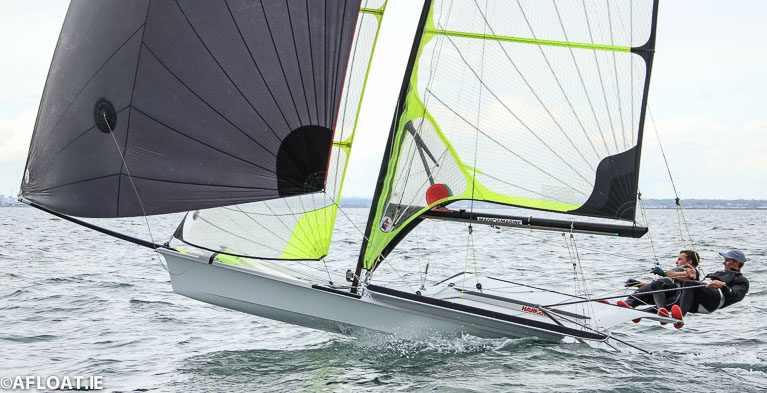 Robert Dickson and Seán Waddilove are New Zealand bound Photo: Afloat
Robert Dickson and Seán Waddilove are New Zealand bound Photo: Afloat
As many as 400 of the world’s best sailors, including New Zealand’s Peter Burling and Blair Tuke and Alex Maloney and Molly Meech, are expected to compete at the Royal Akarana Yacht Club from December 3-8.
Not only will world titles be on the line, but many countries will be using it as an Olympic selection event so the stakes will be high.
Sky Sport will screen live all six days of racing – six races a day – and also produce a daily highlights package, which will also be shown on free-to-air partner Prime TV.
On-the-water gyroscopic cameras will capture all the racing action, including state-of-the-art drones, and there will be comprehensive analysis and interviews from the boat park before and after the racing presented by a team of sailing experts.
Tracking and animation will also be provided by Animation Research Ltd, who are world leaders in graphics visualisation.
“We’re proud to be the host broadcaster for this great event, and we look forward to bringing sailing fans racing coverage from December 3-8 on Sky Sport,” Sky head of sports production Brian Hitchcock said.
The scale of the production is believed to be a world-first for an Olympic class regatta and will enable New Zealand fans to get close to the action. Negotiations are also progressing to distribute the feed internationally.
The 49er, 49erFX and Nacra 17 are arguably the most exciting of all of the Olympic classes, with the boats reaching speeds in excess of 20 knots.
Burling and Tuke have made a successful comeback to the 49er after a couple of years focusing on the America’s Cup and Ocean Race, winning last month’s Olympic test event in Japan, and will be looking to add a fifth world title in December.
“We are thrilled to have Sky Sport New Zealand broadcast our upcoming world championship,” 49er, 49erFX and Nacra 17 president Spillane said. “The 2019 49er, 49erFX, and Nacra 17 world championships are likely to be the most competitive regatta in all of sailing this year.
“To have a passionate New Zealand audience and our global fanbase be able to watch the whole thing is wonderful for the sport.”
The regatta is one of the highlights on the upcoming sailing calendar, which also includes February’s RS:X world championships in Auckland as well as the 2021 America’s Cup.
“It’s a great time to be involved in sailing in this country,” Yachting New Zealand chief executive David Abercrombie said. “With Sky Sport’s partnership, we have an opportunity to further inspire our young sailors through sharing content, telling stories and showing live just how exciting sailing, and in particular, 49er, 49erFX and Nacra 17 sailing, can be.
“As a passionate nation of sports enthusiasts and sailors, we look forward to what promises to be an exciting week of competition and thank Sky Sport for their commitment to work with us in showcasing sailing and Auckland and New Zealand.”
Defending Howth Duo Win Final Day to Claim Medal, But New Zealand Dominate 49er Junior World Champs
The final day highlighted a brilliant advance up the leader board for 2018 Junior World Champions, Robert Dickson and Sean Waddilove of Howth Yacht Club. The duo started out the regatta with their worst two results of the week, a 21, and then a 14, which ended up being their worst two races. They built improving momentum throughout the week and finished with a 5, 1, 3 to win the final day and grab the bottom rung of the podium. They only just hung on to that third place finish fending off a protest in the final day from the Polish in fourth place overall.
Also moving up on the podium were the British pair of James Grummet and Daniel Budden. They sailed a consistent week, only counting top 10 finishes, and when the Australian team of Hansen and Hoffman suffered two poor races in a row on the final day they were able to grab the silver.
But the week belonged to McHardie and McKenzie (NZL) from New Zealand. The pair were the highest-ranked team entering the competition and hardly made any mistakes during the week. They won 5 of the 14 races and discarded a 10th place, their worst result of the week. The duo are part of an extremely talented squad of New Zealand emerging 49er sailors who also had a top 10 finish at Kiel Week. Now they move on to train at the Olympic venue in Enoshima, Japan. New Zealand will be hosting the 2019 World Championship in Auckland so they’ll be playing host to the fleet in a few months time.
Claiming the U21 prize were 4th overall Mikolaj Stanijul and Kuba Stzorch (POL) who were in medal contention all week. At ony 18 years old each, this duo has a bright future ahead.
A second Irish pairing Sean Donnelly and Adam Hyland were 14th in the 53-boat fleet. Results are here
“Sailors of the Year” Robert Dickson & Sean Waddilove Have Shown Special Determination From an Early Age
There is no other event quite like the annual Afloat.ie Volvo Irish Sailing Awards writes W M Nixon. Ireland is small enough for most of the key people in sailing ashore and afloat to know each other personally. So it becomes for all the world like a very extended family gathering, albeit with upwards of 500 people there last night. Yet at the same time, our island is large enough to produce such a variety of sailing and boat types, with the talents to race and sail them well, that a celebration like this ultimate family party in the RDS has a virtually global scope.
And the contribution made in exceptional performance and other special ways which qualified the 26 contenders for the “Sailor of the Year” title were such that it wouldn’t be accurate to describe the Robert Dickson & Sean Waddilove achievement as the peak of a mountain of national success in sailing.
On the contrary, it would more accurately capture the flavour of it all to assert that their outstanding Gold Medal in the Olympic 49er U23 Worlds in Marseille at the beginning of September was seen as the highest peak in an extensive mountain range of Irish sailing success and special achievement, a very complex mountain range which spreads across an astonishing variety of sailing disciplines.
 A Gold Medal deserves recognition at the highest level. Robert Dickson (left) and Sean Waddilove with Leo Varadkar TD during the Taoiseach’s visit to Howth Yacht Club in December
A Gold Medal deserves recognition at the highest level. Robert Dickson (left) and Sean Waddilove with Leo Varadkar TD during the Taoiseach’s visit to Howth Yacht Club in December
While the Frank Bethwaite-designed Olympic 49er may have been around for two decades now, for most sailors it still looks like something out of a future beyond Star Wars, while others might argue that its origins would more likely be found in Lethal Weapon. Either way, this is no sailing machine for the faint-hearted, and it has taken its injury toll on Irish Olympic wannabes.
Yet the wonder of the annual Irish sailing awards is that last night the Dickson/Waddilove triumph found itself pitched against a lineup which included no less than three other contenders who had been sailing hefty gaff-rigged craft in waterborne endeavours of a totally different type, and somehow it all seemed to make sense in a shared love of the sea and sailing.
Certainly, the solid group of supporters from Dungarvan who were there for Maire Breathnach and her award-winning cruise to northeast Greenland in the impressive 64ft gaff cutter Annabel J were in no doubt that it was right up there among the best, and well worth cheering.
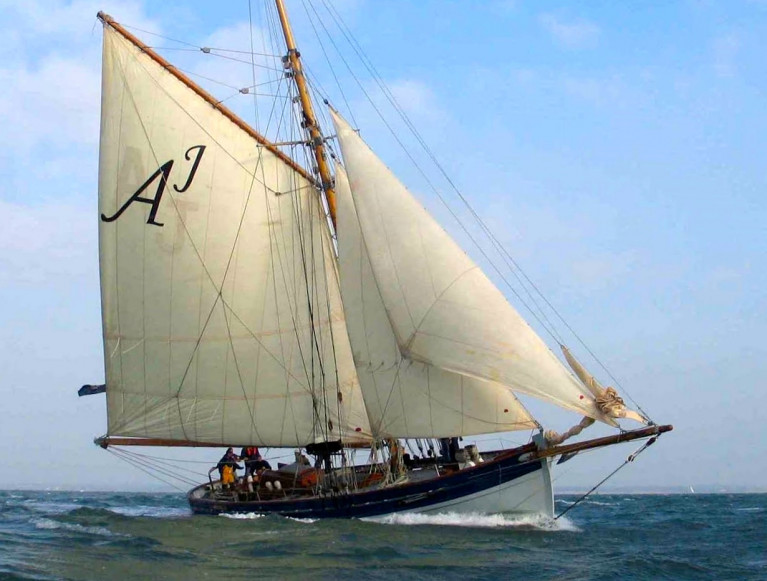 The 64ft gaff cutter Annabel J with which Maire Breathnach of Dungarvan cruised to northeast Greenland.
The 64ft gaff cutter Annabel J with which Maire Breathnach of Dungarvan cruised to northeast Greenland.
Equally, a very representative group from the Defence Forces was there in strength to give well-earned support for their man Commandant Barry Byrne and his team, with their achievement in multiple class victories with the J/109 Joker 2 in the Volvo Round Ireland Race in July, followed by the successful retention of the Beaufort Cup in Volvo Cork Week.
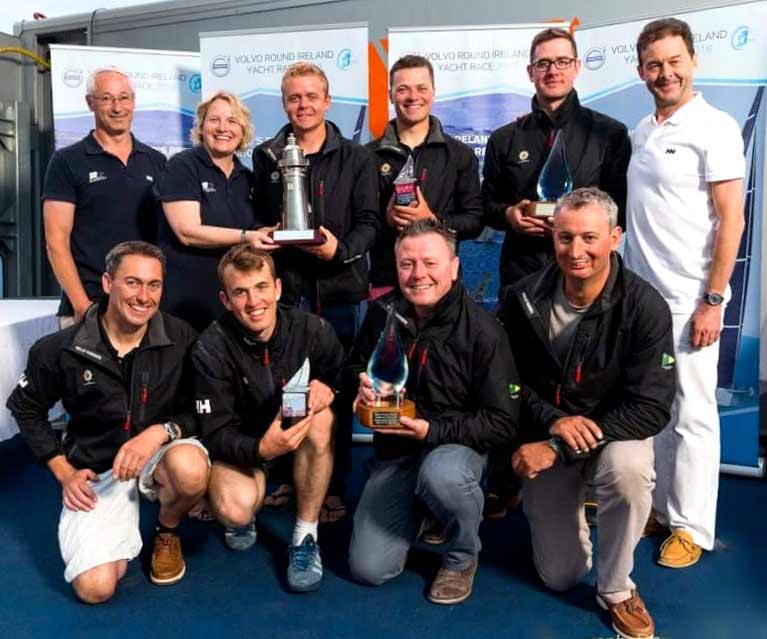 Commandant Barry Byrne (third left back row) with his crew and the reception committee at Wicklow after he’d led the Defence Forces to success in the Volvo Round Ireland Race in July.
Commandant Barry Byrne (third left back row) with his crew and the reception committee at Wicklow after he’d led the Defence Forces to success in the Volvo Round Ireland Race in July.
And though the youngest sailors have their own categories coming directly from Irish Sailing, some of their achievements were so outstanding that they deserved to be in the open category against all-comers, and thus we had the Optimist victories of Justin Lucas of Cork and Tralee to be individually highlighted, as was the success of Hugh O’Connor of the National YC in Dun Laoghaire in managing to pull second overall out of the biggest Topper fleet ever seen at the largely windless Topper Worlds in China.
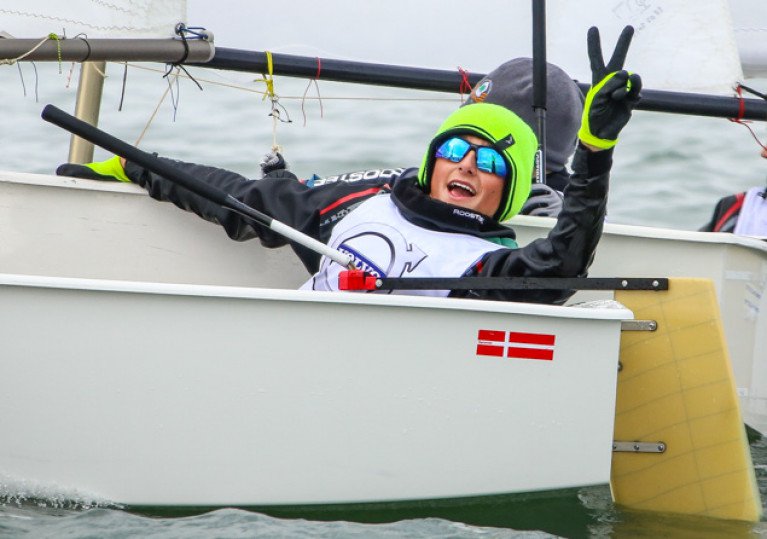 Although Justin Lucas’s successes at home and abroad in the Optimists were very much in the junior division, they were so outstanding that he was Sailor of the Month for April in the Open category. Photo: Afloat.ie/David O’Brien
Although Justin Lucas’s successes at home and abroad in the Optimists were very much in the junior division, they were so outstanding that he was Sailor of the Month for April in the Open category. Photo: Afloat.ie/David O’Brien
Faced with such a selection of talent and success, the adjudicators had no easy task, for the online poll – in which thousands participated - is just part of the final selection process, albeit a very important part. But in the end, after one of the most exhausting adjudicating sessions of recent years, the white smoke went up for the Dickson/Waddilove team.
Anyone who has been following the story of their lengthy but steadily developing progress – which was originally aimed at the 2024 Olympics – will be well aware of just how keen and dedicated these two young sailors are in their aim of getting to the top in two-man dinghy racing at the highest international level.
 The role of Ireland’s classic One Design classes was also recognized last night – this is August’s winner Darragh McCormack of Foynes on his way to the well-supported Mermaid National Championship at his home port on the Shannon Estuary
The role of Ireland’s classic One Design classes was also recognized last night – this is August’s winner Darragh McCormack of Foynes on his way to the well-supported Mermaid National Championship at his home port on the Shannon Estuary
When others of their age might have been literally messing about in boats, Dickson from Howth and Waddilove from Skerries recognised kindred spirits in each other. They saw shared ambitions which could – if properly harnessed – result in an almost monastic dedication to the highest ideals of sailing achievement.
And from a human point of view, the story has everything, as Dickson is a cradle sailor – his grandfather is boat legend Roy Dickson, while his sailing father Ian well appreciates what he has undertaken – while Waddilove by contrast is out of the blue. As a teenager he availed of one of the Try Sailing courses at Skerries, he was almost immediately hooked, and his family have also been as supportive as they can of a mission which has inevitably developed as one long hard road.
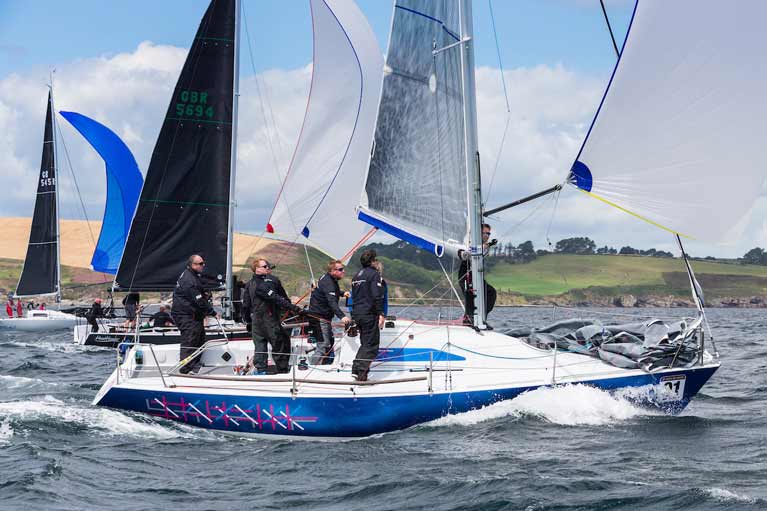 Dave Cullen with his immaculate Classic Half Tonner Checkmate XV became June’s Sailor of the Month for his overall win in the new Wave Regatta at his home port of Howth, and overall wins in the Dun Laoghaire Regattas. Then in August he went to Belgium and won the Half Ton Classic Worlds
Dave Cullen with his immaculate Classic Half Tonner Checkmate XV became June’s Sailor of the Month for his overall win in the new Wave Regatta at his home port of Howth, and overall wins in the Dun Laoghaire Regattas. Then in August he went to Belgium and won the Half Ton Classic Worlds
At a key stage of their joint development, they came under the coaching wing of the inspiring “Polish Sailing Svengali”, Tytus Konarzewski, and a daunting six-year programme of continuing development towards the 2024 Olympics was in being. But September’s Gold Medal at Marseille has raised all sorts of new possibilities, and during the winter the pair have been training with other Irish 49ers at Vilamoura in Portugal.
They were briefly home for Christmas and a spot of R&R, but for athletes training intensely at this level, R&R isn’t quite what the rest of us might think - somehow they found time on Christmas Day itself for “a short 10km training run”.
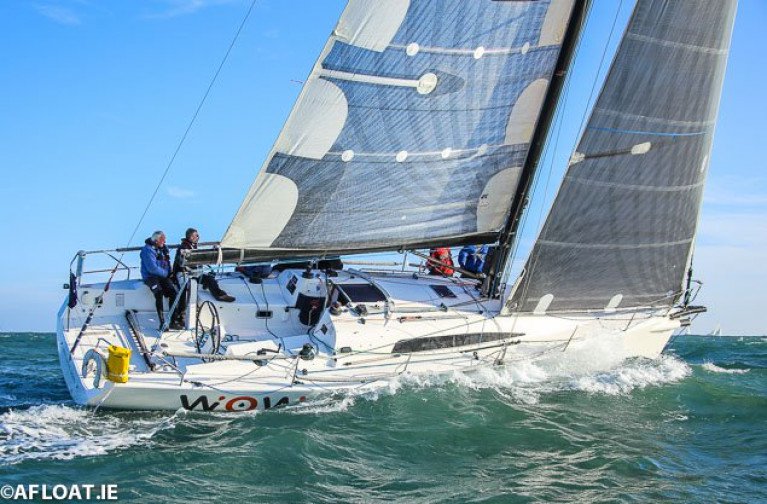 The Awards also gave proper recognition to those whose voluntary work keeps Irish sailing up and running. This is veteran owner-skipper George Sisk’s Farr 42 WOW revelling in the racing in November in the annual Dublin Bay SC Turkey Shoot Series, which provides seven Sunday mornings of superb racing in the long lead-in to Christmas. Turkey Shoot organizer Fintan Cairns was a December “Sailor of the Month” in recognition of his inspiration and organisation of this popular series. Photo: Afloat.ie/David O’Brien
The Awards also gave proper recognition to those whose voluntary work keeps Irish sailing up and running. This is veteran owner-skipper George Sisk’s Farr 42 WOW revelling in the racing in November in the annual Dublin Bay SC Turkey Shoot Series, which provides seven Sunday mornings of superb racing in the long lead-in to Christmas. Turkey Shoot organizer Fintan Cairns was a December “Sailor of the Month” in recognition of his inspiration and organisation of this popular series. Photo: Afloat.ie/David O’Brien
Since then they’ve been on a busy routine with guidance from Ross Killian, Mark McCabe and Irish Sailing’s James O’Callaghan and Rory Fitzpatrick in Vilamoura with the two other Irish 49ers of the Donnelly brothers Tadgh and Sean of the National YC, and Ryan Seaton and Seafra Guilfoyle of Ballyholme and Royal Cork respectively.
Their return to Ireland to collect the award will be only the briefest, although they did find time on Thursday to make their number in Howth YC and belatedly collect the Silver Fox Trophy for HYC’s top achievers in 2018. But although the next major staging post in their programme is the Princess Sofia Regatta 2019 at Palma from 30th March to 6th April, there’s a lesser-known 49er Championship called the Portugal Grand Prix coming up next week from February 14th to 17th at Vilamoura, and it seems to be rising in stature by the minute.
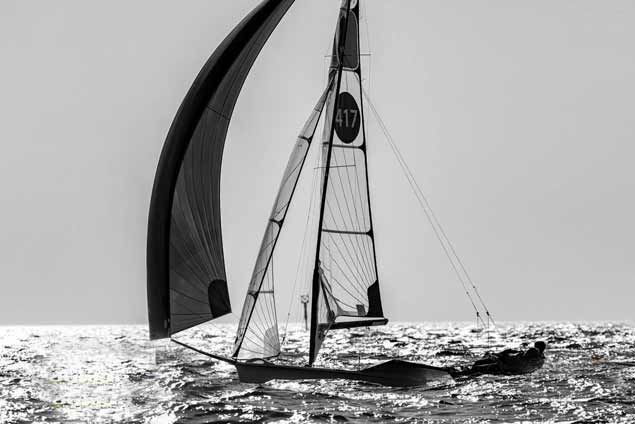
At it, Dickson and Waddilove had planned mainly to work on improving their starting techniques. But after hastening back to Portugal after collecting their award last night, they may well find they’re getting more attention than expected. This morning, however, the rest of us can simply reflect on the wonder that is Irish sailing today.
Sailor of the Month (Olympic Award) for September for Robert Dickson & Sean Waddilove
The Olympic 49er skiff is one of sailing’s greatest challenges, but Robert Dickson (21) of Howth and Sean Waddilove (20) of Skerries have determinedly battled their way up the class’s international performance ladder. Their total dedication was rewarded in September at the Class’s Under 23 Worlds at Marseille. There, the Mediterranean provided a wide variety of conditions, yet they suited Dickson & Waddilove every which way, and they came home with the Gold Medal, their first major win.




























